
Goblin Shark
The Atlantic bluefin tuna (Thunnus thynnus) is a highly migratory, large pelagic fish renowned for its size, speed, and commercial value. It is a top predator in the marine ecosystem and plays a crucial role in maintaining the balance of ocean life.
30 70 years
Lifespan
300 - 620 cm
Length
Least Concern
Conservation Status
5 km/h
Swimming speed
Carnivorous
Diet
Local Migration
Migration
Appearance Overview
The Atlantic bluefin tuna is a large, streamlined fish with a metallic blue-black back and a silvery-white belly.
Coloration
Dark metallic blue on top, silvery-white underside
Body Shape
Torpedo-shaped, built for speed and endurance
Fins
Two dorsal fins, the first depressible into a groove; small finlets behind dorsal and anal fins
Length
Up to 13 feet (4 meters)
Weight
Up to 2,000 lbs (907 kg)
Diet
Carnivorous, feeding on a variety of fish (such as herring, mackerel, and hake), squid, and crustaceans.
Feeding Behavior
Highly active predator, often hunting cooperatively in schools, using speed and agility to capture prey.
Social Behavior
Forms large schools, especially during migration and spawning; exhibits complex social behaviors.
Commercial Relevance
Extremely high value, particularly in the sushi and sashimi markets, where it can fetch premium prices.
Conservation measures
Subject to strict international fishing quotas, monitoring programs, and efforts to reduce bycatch; some marine protected areas.
Status
Endangered (Varies by population segment; some are considered critically endangered)
Threats
Overfishing, driven by high demand in the sushi market; habitat degradation; climate change affecting prey distribution.
Habitat Distribution
Depth Range
0-1,000 meters (typically found in the upper layers of the ocean)
Geographic Range
Atlantic Ocean, Mediterranean Sea, and occasionally into the Black Sea
Preferred Environment
Temperate and subtropical waters; pelagic (open ocean) environments
Reproduction and Life Cycle
Breeding Habits
Spawns in warm waters, primarily in the Mediterranean Sea and the Gulf of Mexico; highly synchronized spawning events.
Development Stages
Eggs hatch into larvae, which develop rapidly in plankton-rich waters; juveniles grow quickly, forming schools.
Fecundity
Females can produce up to 30 million eggs per spawning season.
Maturity Age
Matures at 4-8 years (Mediterranean) or 8-12 years (western Atlantic).
Faqs about Goblin Shark
How long do Atlantic bluefin tuna live?
They can live up to 40 years, though this is rare due to fishing pressure.
How fast can Atlantic bluefin tuna swim?
They are among the fastest fish in the ocean, capable of bursts of speed up to 40-60 mph.
Are bluefin tuna warm-blooded?
Yes, they are warm-blooded, which helps them maintain high activity levels in cold waters.
How far do Atlantic bluefin tuna migrate?
They migrate thousands of miles across the Atlantic Ocean, often returning to the same spawning grounds.
Where do Atlantic bluefin tuna spawn?
They spawn in the Mediterranean Sea and the Gulf of Mexico.
How many eggs do female bluefin tuna lay?
Females can release millions of eggs during a single spawning season.
What do Atlantic bluefin tuna eat?
They primarily eat fish, squid, and crustaceans.
What is the biggest threat to Atlantic bluefin tuna?
Overfishing is the biggest threat, driven by the high demand for their meat.
When do Atlantic bluefin tuna reach maturity?
They reach sexual maturity at around 4-8 years of age, depending on the population.
How is bluefin tuna fishing regulated?
International organizations like ICCAT set fishing quotas and regulations to manage bluefin tuna stocks.
Copyright @ Nature Style Limited. All Rights Reserved.
 English
English